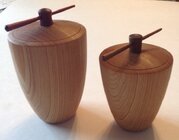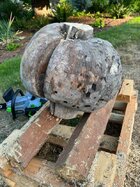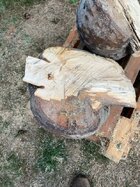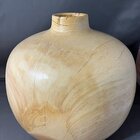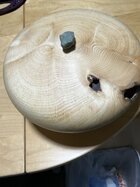I recently obtained a large number of once turned bowls that varied in age from 5 to 16 years in age. Various hardwoods native to western Washington, all properly turned, ready to remount and turn. Stored in an enclosed outside shed. I moved them to eastern Washington and their moisture content now reads 6-7%. Upon turning I’m finding the wood is prone to easily cracking for no good reason and some actually seem to be brittle. By way of experience I usually obtain green wood, once turn it and let it dry until it quits losing moisture, again 6-7%. The wood turns well, not like these older bowls. Is it possible for wood to get too old to turn well?
-
December 2025 Turning Challenge: Single Tree! (click here for details) -
Congratulations to Bob Henrickson, People's Choice in the November 2025 Turning Challenge (click here for details) -
Congratulations to Steven Gordon for "Dropped Ice Cream Cone" being selected as Turning of the Week for December 9, 2025 (click here for details) -
Welcome new registering member. Your username must be your real First and Last name (for example: John Doe). "Screen names" and "handles" are not allowed and your registration will be deleted if you don't use your real name. Also, do not use all caps nor all lower case.
You are using an out of date browser. It may not display this or other websites correctly.
You should upgrade or use an alternative browser.
You should upgrade or use an alternative browser.
Can wood get too old..?
- Thread starter Bernie Kopfer
- Start date
Hmmmmm, Will follow this to see what others say but I have not heard of this.
My recollection of Washington is west is wet and east is dry. If you are using a surface moisture meter maybe the outside of the blank is dry, but the inside of the bowl blank has a higher moisture. If you use a scale to weigh them and record the weight over time you should be able to determine if they are gaining or losing weight or at equilibrium. Differences in moisture within the blank would be a stress and could result is the behavior you observed. I am skeptical that age would explain this behavior.
Change of location will greatly affect any seasoned wood, you have to let acclimatize to it new surroundings. As an example, on a short trip to New Zealand I picked a couple of blanks the had been in storage in excess of 10 years. Moisture tested in NZ at 10% which was fine. With in 10 days of putting into storage in Australia, they opened like a banana, totally useless for hollow vessels. I didn't make any attempt to acclimatize and so paid the price.I recently obtained a large number of once turned bowls that varied in age from 5 to 16 years in age. Various hardwoods native to western Washington, all properly turned, ready to remount and turn. Stored in an enclosed outside shed. I moved them to eastern Washington and their moisture content now reads 6-7%. Upon turning I’m finding the wood is prone to easily cracking for no good reason and some actually seem to be brittle. By way of experience I usually obtain green wood, once turn it and let it dry until it quits losing moisture, again 6-7%. The wood turns well, not like these older bowls. Is it possible for wood to get too old to turn well?
- Joined
- Feb 28, 2021
- Messages
- 1,766
- Likes
- 1,579
- Location
- Roulette, PA
- Website
- www.reallyruralwoodworks.com
Umm.. so how is it folks are turning 15,000 year old bog oak , among other things... Nah wood cant get too old, but it can move - and moving too fast (like any other old thing, like me!) is seldom good for it - so one wants to slow down the rate of which it moves and surest way to do that is breathable but wrapped - such as in brown paper bags... and let it acclimatize a month or more to its new environment , then just check for moisture *STABILITY* by weight (I weigh mine in grams) once it stops gaining or losing weight for a month or so then it's pretty much at equilibrium with its environment - no need for moisture % which often only reads a few millimeters deep and won't tell you how wet or dry the wood is in the middle
As others have said the blanks need to stabilize in your dryer climate. Paper bags and weighing is the easiest and simplest method I know of.
Although these blanks are not stabilized for your drier climate, they will still turn as dry wood, which is much different than turning wet wood. Dry wood is physically harder and more brittle vs wet, ie normal behavior. Dry wood will dull edges faster, and will have more force on the tool edge vs wet. Take lighter cuts and sharpen more often.
With dry bowl blanks, I get the tenon returned, and get the OD ~90% round, then turn the ID ~90% round, then finish the OD. This releases stress and the OD will stay more round as the bowl is finished.
Although these blanks are not stabilized for your drier climate, they will still turn as dry wood, which is much different than turning wet wood. Dry wood is physically harder and more brittle vs wet, ie normal behavior. Dry wood will dull edges faster, and will have more force on the tool edge vs wet. Take lighter cuts and sharpen more often.
With dry bowl blanks, I get the tenon returned, and get the OD ~90% round, then turn the ID ~90% round, then finish the OD. This releases stress and the OD will stay more round as the bowl is finished.
Well, that move is a pretty drastic change in climate. Not sure what the problem is. If they were still in western WA, probably fine. I don't know if putting them in a higher humidity chamber for a week or so would help or not. Some may depend on the wood species too.
robo hippy
robo hippy
Age of the wood has absolutely nothing to do with it turning well. Especially if you consider 16 years as old!!!! I turned this boxes from 110 year old long leaf pine. I recycled them from window framing in an old building. EDIT; There is a better likelihood that the wood had minute cracks that you didn’t see before you turned it.
Attachments
Mark Hepburn
Artist & Chef
Those boxes are beautiful
Thanks Mark. The issue with turning these was the incredibly high resin content of the wood. Dry sanding was impossible. Just touching the wood with dry sandpaper caused it to instantly gum up. Mineral spirits wet sanding was the only way to sand it.Those boxes are beautiful
Mark Hepburn
Artist & Chef
That is a great tip, Richard. I’ve run across some gummy wood although I can’t recall the species and didn’t really know how to deal with it.
Cypress isn’t the best way to turn and it’s definitely not the best to sand on the lathe.
Cypress isn’t the best way to turn and it’s definitely not the best to sand on the lathe.
I was tasked with turning something from some very old Oak from a house restoration. The wood came from the original structure so was several hundred years old and very dry.
Impossible to turn as it was but I read about a trick for difficult to turn timbers. I soaked it for a few months in a 50/50 mixture of liquid dish soap and water. It was then left to drain for a couple of weeks. It didn’t turn too badly until I hit a cut nail hidden inside. The resultant Bowl I turned from it looked ok though. I finished it in Danish Oil I think. The house owner was pleased with it.
Impossible to turn as it was but I read about a trick for difficult to turn timbers. I soaked it for a few months in a 50/50 mixture of liquid dish soap and water. It was then left to drain for a couple of weeks. It didn’t turn too badly until I hit a cut nail hidden inside. The resultant Bowl I turned from it looked ok though. I finished it in Danish Oil I think. The house owner was pleased with it.
IMO...yes, BUT, it depends on the species, how it was cut/turned, and what climate it was stored in. I just disposed of a couple of blanks that were so old and dry it was like turning dust. Fortunately wood is very cheap for me.I recently obtained a large number of once turned bowls that varied in age from 5 to 16 years in age. Various hardwoods native to western Washington, all properly turned, ready to remount and turn. Stored in an enclosed outside shed. I moved them to eastern Washington and their moisture content now reads 6-7%. Upon turning I’m finding the wood is prone to easily cracking for no good reason and some actually seem to be brittle. By way of experience I usually obtain green wood, once turn it and let it dry until it quits losing moisture, again 6-7%. The wood turns well, not like these older bowls. Is it possible for wood to get too old to turn well?
So, I feel compelled to ask too old or too dry?IMO...yes, BUT, it depends on the species, how it was cut/turned, and what climate it was stored in. I just disposed of a couple of blanks that were so old and dry it was like turning dust. Fortunately wood is very cheap for me.
...dry
A list of those species that get too dry would give some credence to your comment. My feeling is that the turner’s skill, tool choices, and techniques has a lot more to do with this wood moisture content disqualification for turning. Around here, wood never goes below 12% if it just sits on a shelf for years. Also to be considered is the OP asked if age can disqualify wood for turning, not moisture. I’ve seen examples of 4,000 year old redwood being turned....dry
Mark Hepburn
Artist & Chef
I have some bog oak that I turn. It turns easily and is something like 5,000 years old and it's been drying in my shop for over a year.
- Joined
- Apr 27, 2004
- Messages
- 9,302
- Likes
- 6,057
- Location
- Lakeland, Florida
- Website
- www.hockenberywoodturning.com
Green wood is by its nature more fun to turn than dry wood.By way of experience I usually obtain green wood, once turn it and let it dry until it quits losing moisture, again 6-7%. The wood turns well, not like these older bowls. Is it possible for wood to get too old to turn well?
It is quite possible there are cracks in your dried bowls that you didn’t/couldn’t see until you did some turning.
I fought this is your problem but Its possible for a bouncing tool to crack a bowl on returning.
You have a lot of interrupted cuts when returning a bowl, rim, outside, inside.
An endgrain turned bowl is more easily cracked than the more common face grain turned bowl
This is how I mount and return a dried bowl - the second half of a demo after I turn a green bowl for drying first.
In January 2017 I did a demo for tri-county Woodturner's about working with green wood. It had three parts: Overview of wood and tips for successful drying, Roughing a green bowl, and Re-turning the dry bowl. Special thanks to Jan Brown for excellent video work and to Carl Brown for Setting up all the gear and making the DVD.
Below is the video of the Re-turning a dry bowl part. It shows the way I mount and turn a dried bowl mostly using the Ellsworth gouge. I also use a small bowl gouge with a Michelson grind for the first inch of the inside and spindle gouge for reshaping the...
Below is the video of the Re-turning a dry bowl part. It shows the way I mount and turn a dried bowl mostly using the Ellsworth gouge. I also use a small bowl gouge with a Michelson grind for the first inch of the inside and spindle gouge for reshaping the...
- hockenbery
- bowl dry return
- Replies: 2
- Forum: Tutorials and Tips
Wood always move with the seasons and hardens over time. There is story out that Stradivarius his secret he may have had access to some very old wood [600 years old] from a nearby monastery that was undergoing some maintenanceUmm.. so how is it folks are turning 15,000 year old bog oak , among other things... Nah wood cant get too old, but it can move - and moving too fast (like any other old thing, like me!) is seldom good for it - so one wants to slow down the rate of which it moves and surest way to do that is breathable but wrapped - such as in brown paper bags... and let it acclimatize a month or more to its new environment , then just check for moisture *STABILITY* by weight (I weigh mine in grams) once it stops gaining or losing weight for a month or so then it's pretty much at equilibrium with its environment - no need for moisture % which often only reads a few millimeters deep and won't tell you how wet or dry the wood is in the middle
That comment got me thinking Hughie. "Tone" woods are a whole different thing. There is a process called "torrefied" wood where they bake it to artificially "create" the tones from long dried wood. Don't know the exact process. I know really old growth trees are preferred, if you can find them. Well, find them legally....
robo hippy
robo hippy
Robo, Found this, very interesting, thanks for the heads upThat comment got me thinking Hughie. "Tone" woods are a whole different thing. There is a process called "torrefied" wood where they bake it to artificially "create" the tones from long dried wood. Don't know the exact process. I know really old growth trees are preferred, if you can find them. Well, find them legally....
robo hippy
Torrefied wood is wood that undergoes a high-temperature, oxygen-free thermal process called torrefaction, which removes moisture and volatile organic compounds, altering its cellular structure to make it lighter, more stable, and resistant to humidity. This process results in a "cooked" or "aged" character, enhancing sound quality in instruments like guitars by making them more resonant and responsive, and can also be used to produce energy-dense biomass for fuel.
The Torrefaction Process
- Drying:
The wood is placed in a specialized drying chamber with the air removed to prevent it from burning.
- Heating:
High temperatures, typically between 375 and 465°F (190-240°C), are used to remove water, sugars, and oils from the wood. - Re-moisturizing:
After the initial drying and heat treatment, moisture is reintroduced to bring the wood's content to around 3-6% for stability. - Structural Changes:
The process alters the wood's cellular structure, similar to natural aging over decades, changing open-cell structures to closed-cell.
- Heating:
- Increased Stability: Less susceptible to moisture, reducing warping, bending, and cracking, making it ideal for instruments and structural applications.
- Improved Sound: In instruments, torrefied wood can provide a richer, warmer tone and greater responsiveness due to enhanced sound velocity and reduced damping.
- Lighter Weight: The removal of moisture and volatile compounds makes the wood lighter.
- Enhanced Energy Value: When used for fuel, torrefied wood becomes more energy-dense and can serve as a coal alternative.
- View: https://www.youtube.com/watch?v=TCk-p6aQWaI&t=56s
As I recall, @Michael Anderson did some work with torrefication, which he posted.
Various hardwoods native to western Washington, all properly turned, ready to remount and turn. Stored in an enclosed outside shed. I moved them to eastern Washington and their moisture content now reads 6-7%. Upon turning I’m finding the wood is prone to easily cracking for no good reason and some actually seem to be brittle.
Bernie, I may have missed it but didn't see where you gave the species names. Some species are far different that others. Are these problem roughed out bowls the same species as some you are used to. If so, maybe the humidity cycling in the outside shed did something to the wood. Non-climate controlled storage is not ideal
I rarely turn bowls but have made a few from green and twice turned some, a few quite old, never experienced that - I almost always make solid blanks instead of twice turn, seal, and dry indoors in my climate-controlled shop, tracking dryness by weight - the only reliable way IMO - I have both pin and pinless meters and both types have limitations. The weight method always works, although it does take a while with larger blanks. I write that month/year and weight in grams on a piece of tape and reweigh every few months. When the weight quits dropping the wood is at EMC and ready to use.

Sometimes wood can develop internal stresses which can cause cracks when turning even if the wood is try. I had one bowl with stresses that cracked so loudly I could hear it from across the room while sharpening a gouge. Cracked again before I got back to the lathe.
It was this one, maple, intended to have a squar"ish" shaped rim but ended up round after cutting away the cracks. (This is the bottom, showing a one variation of a method I like to use - detail like this often surprises a recipient when they turn it over!

One proven way to eliminate stresses is to boil the rough-turned bowl which not only relieves stresses but can reduce drying time. There's been some discussion about boiling you could find using the forum search.
The hardness of dry wood has never bothered me. The denser and harder the wood the more I enjoy turning it. By comparison , I find Iurning green wood is so simple and easy it's not challenging and not much fun. (makes nice shavings though! and provides near-instant gratification) Sharp, sharp, razor-sharp tools are a must for dry, hard wood.
JKJ
Hughie, I had to think to remember.... Daisy Tempest is the young woman I was thinking about who did an episode about torrefied woods, a lovely young woman guitar maker. I think she is down in Australia now.
robo hippy
robo hippy
Could anyone post some facts and numbers about just how much harder wood gets. And just what the rate of hardening is.Wood always move with the seasons and hardens over time.
EDIT; I asked Google AI,
No, a wooden board does not get harder with age; instead, it generally becomes weaker due to factors like insects, rot, and exposure to the elements. While wood can gain strength as it dries, this is a process of reaching its optimal moisture content, not a gain from aging itself. The "hardness" perceived in some old boards is more likely a result of their original density or a specific species of wood.
How wood's strength changes with age
- It typically weakens:
Over time, exposure to moisture, insects, fungi, and excessive stress can degrade wood and make it weaker.
- Drying increases strength:
Freshly cut, "green" lumber is weaker than dry lumber. As wood dries to a lower moisture content (e.g., around 12%), it can be significantly stronger—up to 50% stronger than when it was wet.
- Aging vs. drying:
The increase in strength is not due to age, but due to the drying process. Once dry, age does not continue to make it stronger. - Initial hardness varies:
The initial hardness of a board depends on factors like how the tree grew (e.g., faster-growing trees can result in softer wood with wider rings).
- Petrified wood is an exception:
While normal wood degrades over time, petrified wood is an exception, as it has been mineralized and is much harder than regular wood
Last edited:
Hmm, found this.
AI Overview
Yes, timber does harden with age, especially as it loses moisture over time, which can slightly increase its strength, but this is a gradual process that can take years
. Timber also changes color with age due to chemical reactions like the oxidation of tannins from light exposure, which darkens the wood.
The hardest Australian timber by Janka rating
The Janka test measures the force required to embed a steel ball halfway into a piece of timber, and its results show that Australian Buloke has an exceptional resistance to denting and wear.
I carry most of these in stock and use them often and as mentioned when dry the harness is greatly increased.
AI Overview
Yes, timber does harden with age, especially as it loses moisture over time, which can slightly increase its strength, but this is a gradual process that can take years
. Timber also changes color with age due to chemical reactions like the oxidation of tannins from light exposure, which darkens the wood.
- Hardens slightly with age: As wood dries out and the moisture content decreases, it becomes slightly harder and stronger. This hardening effect can be more noticeable in softer woods like pine.
- Changes color: With age and exposure to light, the chemical compounds in wood, such as tannins, can oxidize and change color, typically causing the wood to darken or develop a yellowed appearance.
- Durability is inherent: The "durability" of a timber species—its natural resistance to decay and pests—is a result of its natural properties, not how old it is. This inherent durability is what determines how long the wood will last in a given environment.
- Average rainfall: Much of Australia's desert interior, including the driest area around the Lake Eyre basin in South Australia, averages only 100 to 140 mm of rain per year. For comparison, this is significantly more than the world's driest deserts, like parts of the Atacama, which may go centuries without rain.
- High variability: Australian desert rainfall is notoriously erratic. While annual averages are low, a single significant rain event can deliver a year's worth of precipitation in a single month or, on rare occasions, a single day. Years with less than half the long-term average are common.
The hardest Australian timber by Janka rating
The Janka test measures the force required to embed a steel ball halfway into a piece of timber, and its results show that Australian Buloke has an exceptional resistance to denting and wear.
- Australian Buloke: 5025 flbs An ironwood that grows in eastern and southern Australia, this wood is famously difficult to work with. It is so hard and dense that it can dull saw blades.
- Gidgee: 4027flbs Sometimes listed as the third-hardest wood in the world, this rare Acacia species grows in arid parts of Australia and is prized by knife makers.
- Grey Ironbark: One of the densest and toughest commercial timbers in Australia, often used for heavy construction, flooring, and decking.
- Red Ironbark: A very dense and hard Australian timber, noted for its deep red color. It is extremely durable and resistant to wear and tear.
I carry most of these in stock and use them often and as mentioned when dry the harness is greatly increased.
Robo, I found her and she is alive and well.Hughie, I had to think to remember.... Daisy Tempest is the young woman I was thinking about who did an episode about torrefied woods, a lovely young woman guitar maker. I think she is down in Australia now.
robo hippy
- Hardens slightly with age: As wood dries out and the moisture content decreases, it becomes slightly harder and stronger. This hardening effect can be more noticeable in softer woods like pine.
The only thing that I have noticed with wood as it gets older is that it gets harder.
A local town here installed some torrified ash on an a ballpark exterior recently. It was cut on the east coast then shipped to Germany for the torrification process, and then shipped here to the west coast. There's a carbon footprint! The lumber dealer said the sugars are cooked out of it making it pest and decay resistant.
There really isnt any definitive answer or study on this that I could find. There is some info on Northern Hemisphere wood species. But much less on Australian species, some of the issue are the huge variety of species and the variations.Slightly is not much of a technical term. What happens when it’s kiln dried and it increases its moisture when it reaches the equilibrium moisture in a damp climate? Does it get softer?
- Hardens slightly with age: As wood dries out and the moisture content decreases, it becomes slightly harder and stronger. This hardening effect can be more noticeable in softer woods like pine.
see here:
There are over 800 species of eucalypt trees native to Australia, with some sources citing numbers around 900 species. The term "eucalypt" is often used to include closely related genera like Corymbia and Angophora, in addition to the genus Eucalyptus itself.
The other aspect is new species:
Recent Australian tree discoveries include a possible new record-holding hoop pine, a newly described desert fig from Uluru, and an undocumented myrtle species found near Gladstone. Other news includes the conservation of rare species like the Wollemi Pine and the Mongarlowe mallee, and research using AI to study changes in eucalypt leaf sizes.
Recent Australian tree discoveries include a possible new record-holding hoop pine, a newly described desert fig from Uluru, and an undocumented myrtle species found near Gladstone. Other news includes the conservation of rare species like the Wollemi Pine and the Mongarlowe mallee, and research using AI to study changes in eucalypt leaf sizes.
Wow, new species! Seems like a slim chance of that around here.
From my limited experience some Australian wood is amazing. A friend on the east coast said he makes expeditions up north to harvest tropical wood. He would send me packages of smallish pieces and once when visiting brought me a suitcase full of bigger blanks! I hire a security service to guard the remaining pieces. (Not quite, but I do keep them hidden from visiting woodturners, especially one...)
Do you recognize the wood in the ring keeper on the right in this photo? (I wrote about it briefly in another post about teaching the skew)
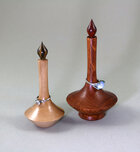
When mailing packages he would send square blanks until his daughter told him it would save on postage if he turned them round first! I wouldn't have thought of that...
I know a guy on the west coast too, sent me a bit of gold from his yard. Are all Australians really, really nice, thoughtful, and friendly people?
JKJ
lol The woody fraternity is very friendly, although our sense of humour can at times seem to be a little strange if not weird by other standards . The wood on the right looks like Buloke, if so it would have been fairly hardWow, new species! Seems like a slim chance of that around here.
From my limited experience some Australian wood is amazing. A friend on the east coast said he makes expeditions up north to harvest tropical wood. He would send me packages of smallish pieces and once when visiting brought me a suitcase full of bigger blanks! I hire a security service to guard the remaining pieces. (Not quite, but I do keep them hidden from visiting woodturners, especially one...)
Do you recognize the wood in the ring keeper on the right in this photo? (I wrote about it briefly in another post about teaching the skew)
View attachment 80566
When mailing packages he would send square blanks until his daughter told him it would save on postage if he turned them round first! I wouldn't have thought of that...
I know a guy on the west coast too, sent me a bit of gold from his yard. Are all Australians really, really nice, thoughtful, and friendly people?
JKJ
I've turned some white oak that came from a 150 year old barn, so I would guess the wood itself is around 200 years or more old. It turns really well, but tends to create more really fine dust while being cut and smells somewhat like burlap. Talk about stable! It's fairly plain, straight grained, but beautiful to work. I think the tendency to form more fine dust is the only thing that I'd blame on it's age.

